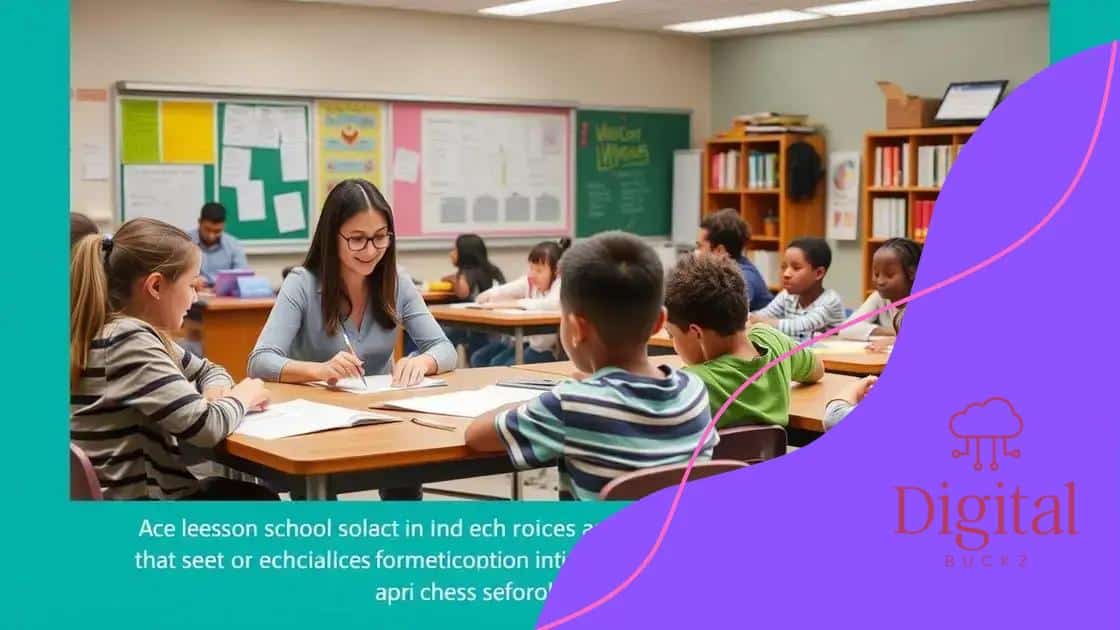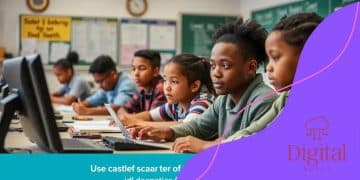Executive orders push school reforms: what you need to know

Executive orders push school reforms to improve accessibility, enhance technology integration, and emphasize social-emotional learning, shaping a more inclusive future for education.
Executive orders push school reforms that significantly shape the educational landscape. These directives can alter curriculum standards, funding allocations, and even classroom dynamics. Ever wonder how these changes might touch students and educators alike?
Understanding executive orders and their implications
Understanding executive orders is crucial in grasping how they affect our educational system. These orders are powerful tools that the President uses to manage operations of the federal government. In the context of school reforms, they can directly influence policies that impact students, teachers, and school administrations.
When an executive order is issued, it typically outlines specific goals and directives intended to bring change. For instance, recent educational reforms aim to address critical issues such as equity in funding and access to resources.
The Role of Executive Orders
Executive orders play a significant role in shaping public education. They allow for rapid changes, often in response to pressing educational challenges. This flexibility helps implement reforms more swiftly than traditional legislative processes.
Key Areas Affected by Reforms
- Curriculum changes to meet diverse student needs
- Allocation of federal funds to schools
- Implementation of new teacher evaluation systems
- Support for under-resourced schools
Moreover, executive orders not only direct federal agencies on how to implement policies but also set the tone for state and local educational practices. This can lead to a ripple effect throughout the entire educational landscape.
As schools adapt to these changes, community involvement becomes vital. Parents, teachers, and administrators must engage in discussions about these reforms to ensure they meet the needs of all students.
Key reforms introduced by recent orders
Key reforms introduced by recent orders have significantly transformed the educational landscape. These reforms target several aspects of the school system, aiming to improve outcomes for students and enhance teaching practices.
One notable reform involves adjusting funding allocations. Schools in underfunded areas are receiving more resources to ensure equitable access to quality education. This means that students who need extra support can finally get the help they deserve.
Changes in Curriculum Standards
Curriculum updates are another vital aspect of these reforms. New standards focus on critical thinking, creativity, and real-world problem-solving skills. This shift ensures that students are not just memorizing facts but are also developing essential skills for their futures.
Teacher Evaluation Systems
- Introduction of comprehensive evaluation methods
- Focus on classroom practices and student growth
- Ongoing professional development opportunities
- Collaboration among educators for feedback and improvement
The introduction of new teacher evaluation systems emphasizes both accountability and support. Teachers are encouraged to grow in their profession, ensuring they provide the best education possible.
Moreover, recent reforms promote the use of technology in classrooms. This includes integrating digital tools to enhance learning experiences. Schools are not just modernizing their classrooms; they are making learning more engaging and accessible for all students.
Impact of reforms on teachers and schools

The impact of reforms on teachers and schools has been significant, reshaping the educational environment. With new policies in place, many educators are experiencing changes in how they teach and interact with students.
One major effect is the shift towards enhanced professional development. Teachers are now encouraged to participate in ongoing training, which helps them improve their skills and adapt to new educational standards. This support system empowers educators to feel more confident and competent in their roles.
Positive Changes for Educators
- Increased collaboration among teachers
- Access to resources and tools for effective teaching
- Higher morale and job satisfaction
- Opportunities for leadership roles
These changes foster a community where teachers can share best practices and learn from one another. As they collaborate, the overall quality of education improves. Schools are beginning to reflect this growth by adopting new teaching methods that engage students and make learning exciting.
Challenges Faced by Schools
Despite the benefits, some challenges remain. For instance, with reforms often come budget adjustments. Schools may struggle to allocate resources effectively while trying to meet new standards. Additionally, teachers might feel overwhelmed by the rapid changes and expectations placed upon them.
Engaging parents and communities is also a significant focus of recent reforms. Schools are encouraging stronger partnerships with families and local organizations. This collaboration helps create a more supportive environment for students. When families are involved, students tend to perform better and feel more connected to their schools.
Community responses to educational changes
Community responses to educational changes have been varied and deeply impactful. As schools undergo reforms, communities are stepping up to voice their opinions and actively participate in the transformation.
One common response is increased engagement from parents. Many are attending school board meetings to understand how these changes affect their children. This involvement creates a dialogue between educators and families, fostering a sense of collaboration.
Support from Local Organizations
Local organizations are also playing a vital role in supporting educational changes. They often provide resources and programs that align with new school initiatives. For example, community centers may offer after-school programs that enhance learning beyond the classroom.
Positive Feedback and Criticism
- Parents appreciate increased communication from schools
- Some community members support reforms but express concerns about funding
- Students are often more engaged in their learning
- Ongoing discussions about inclusion and equity in education
Feedback from the community helps shape the direction of ongoing reforms. While many celebrate the progress, some issues remain unresolved. For instance, discussions about equitable access to resources continue to be a hot topic. Communities are advocating for all students to have the essentials they need to succeed.
Moreover, social media platforms have become a space for parents and community members to connect and share their views on educational policies. This digital engagement helps spread awareness and mobilizes support for necessary changes. As discussions unfold, communities are finding ways to adapt and advocate effectively for their schools.
Future of education under new policies
The future of education under new policies is shaping up to be more inclusive and innovative. As schools adapt to recent reforms, the focus is on creating an environment that maximizes student potential.
One notable trend is the integration of technology into everyday learning. Classrooms are becoming more digitally equipped, with tools that support personalized education. This means students can learn at their own pace, accessing resources that suit their individual needs.
Emphasis on Social-Emotional Learning
Another key aspect is the emphasis on social-emotional learning (SEL). Schools are recognizing the importance of mental health and emotional well-being. Programs are being introduced to teach students skills like empathy, resilience, and collaboration. These skills are vital for fostering a positive school climate and preparing students for future challenges.
Equity in Education
- Increased focus on equitable access to resources
- Support for students with diverse learning needs
- Programs aimed at reducing achievement gaps
- Community partnerships to enhance learning opportunities
Equity remains a central theme. Schools are working to ensure that all students have access to quality education regardless of their background. This includes tailored support for those who face barriers to learning.
Moreover, districts are exploring new teaching methods that cater to diverse learning styles. This adaptability increases engagement and helps students thrive. As educational policies evolve, the collaboration between educators, families, and communities will be essential in making these goals a reality.
FAQ – Frequently Asked Questions about Educational Reforms
What are the main goals of recent educational reforms?
The main goals include improving accessibility, integrating technology, and emphasizing social-emotional learning to benefit all students.
How are communities responding to these changes?
Communities are actively engaging by attending school meetings, providing feedback, and collaborating with schools to support reforms.
What role does technology play in modern education?
Technology is enhancing learning by providing personalized educational experiences and resources that cater to individual student needs.
How can parents get involved in the educational reform process?
Parents can participate by attending meetings, volunteering, and communicating with educators to advocate for their children’s needs.






